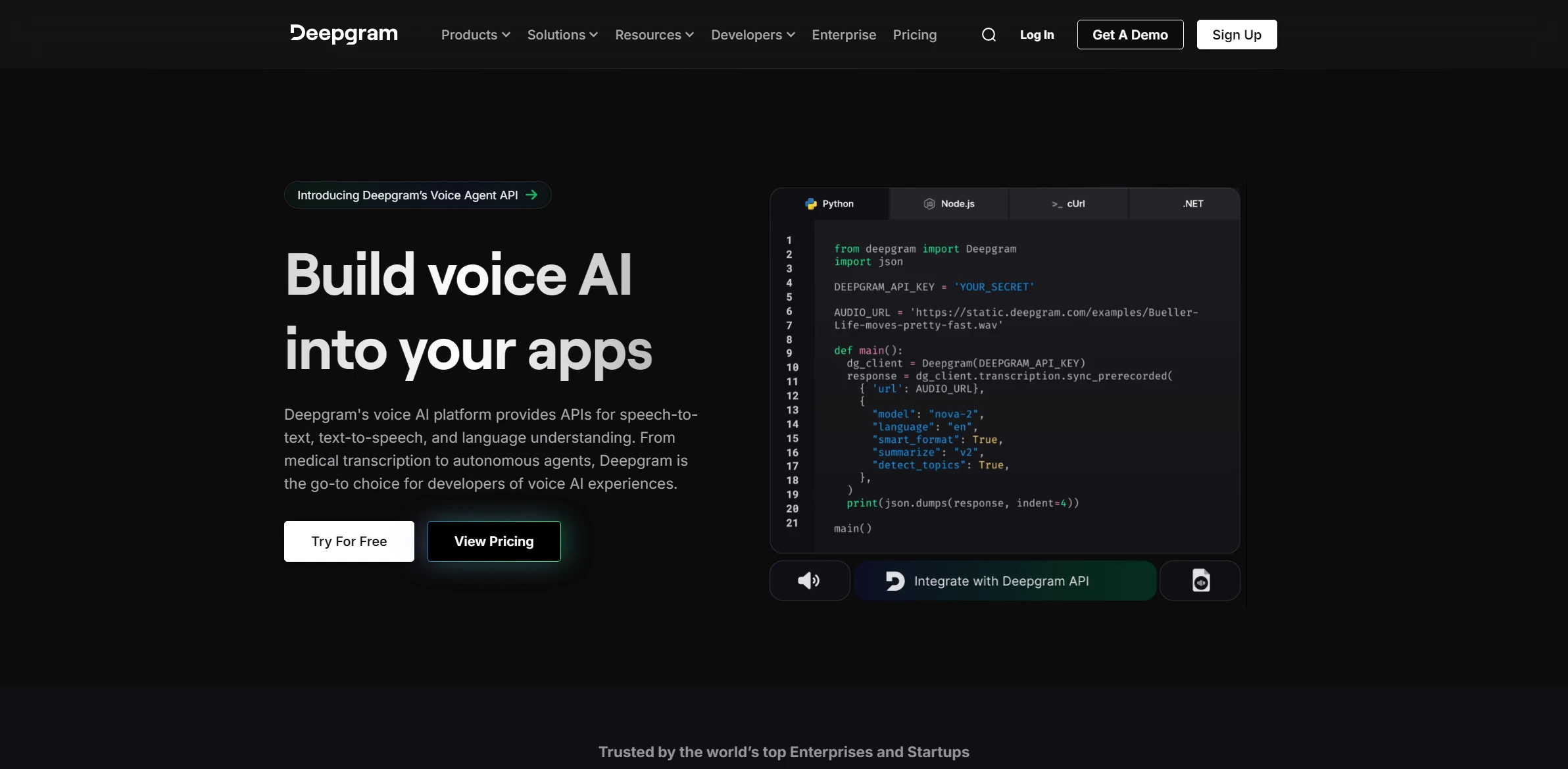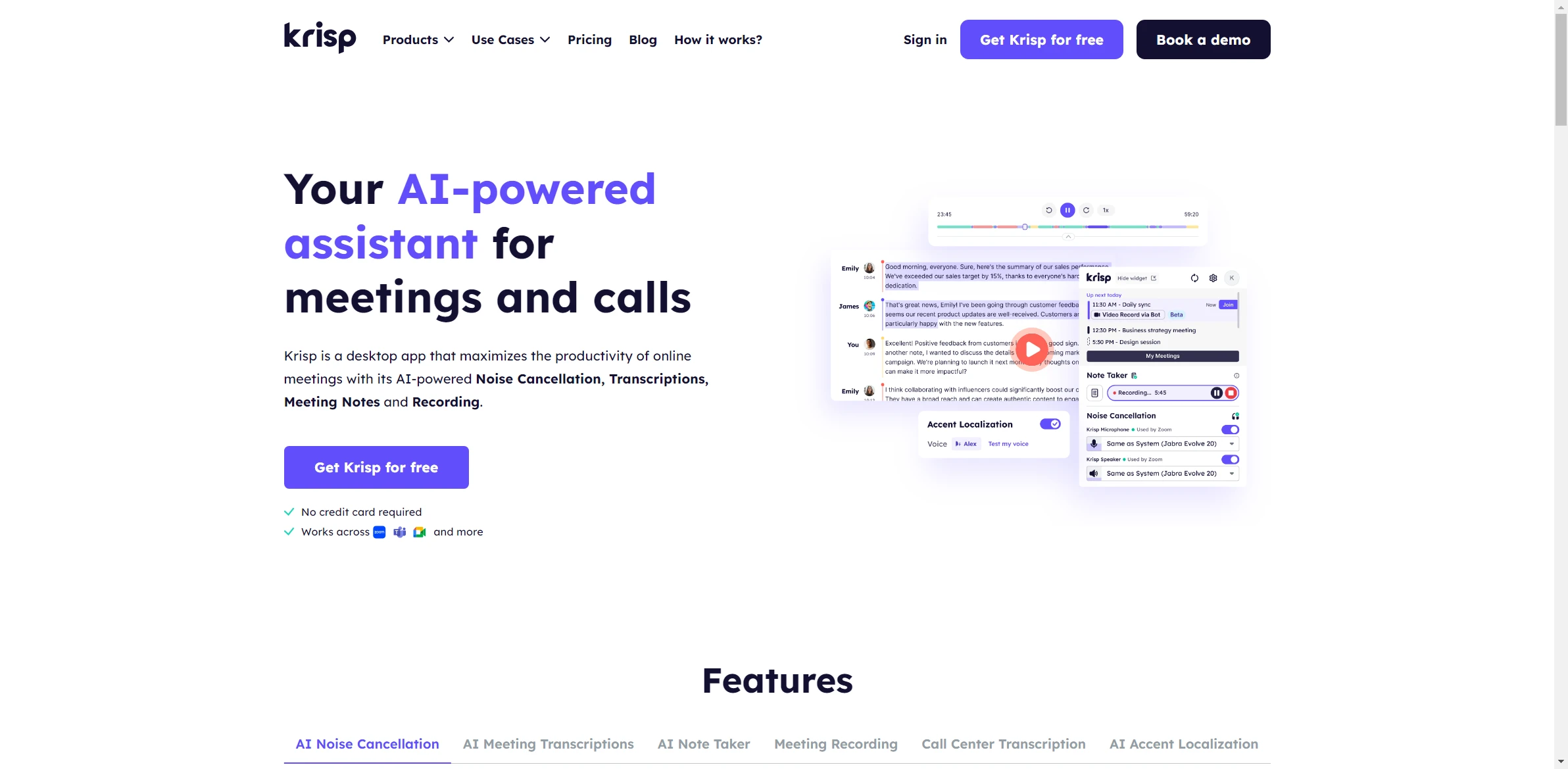Artificial Intelligence Tool Deepgram AI

DESCRIPTION
Deepgram AI is an advanced speech recognition platform that leverages cutting-edge artificial intelligence to convert audio into text with remarkable accuracy. Built on deep learning technology, Deepgram’s algorithms are designed to understand various accents and dialects, making it a versatile tool for businesses and developers alike. Its ability to process natural language allows for real-time transcription, enabling users to capture and analyze spoken content efficiently. This functionality is particularly beneficial for sectors such as healthcare, customer service, and media, where timely and accurate transcriptions can significantly enhance productivity.
One of Deepgram’s standout features is its ability to perform speaker diarization, which distinguishes between different speakers in an audio stream. This functionality is essential for meetings, interviews, and podcasts, where multiple speakers are present. By accurately identifying and labeling each speaker, Deepgram allows users to navigate conversations more effectively, providing context to the dialogue. This capability not only streamlines the transcription process but also aids in improving collaboration and communication among team members, as it enables easier reference to specific parts of the conversation.
The practical impact of Deepgram AI extends beyond mere transcription; it transforms how organizations manage and utilize their audio content. By integrating Deepgram into their workflows, companies can automate the transcription process, thus freeing up valuable time for employees to focus on more strategic tasks. Additionally, the enhanced accessibility of information allows for better decision-making and knowledge sharing within organizations. Overall, Deepgram AI represents a significant advancement in speech recognition technology, offering practical solutions that enhance efficiency and foster collaboration across various industries.
Why choose Deepgram AI for your project?
Deepgram AI stands out for its advanced speech recognition capabilities, leveraging deep learning to achieve high accuracy in various environments, even with background noise. Its real-time transcription is ideal for live events, customer service interactions, and content creation, enabling seamless integration into workflows. Customizable models allow businesses to tailor the AI to specific industry jargon, enhancing performance in sectors like healthcare and finance. Additionally, its API supports rapid deployment, making it easy for developers to implement. Deepgram’s focus on privacy ensures sensitive data remains secure, making it a reliable choice for organizations prioritizing compliance and data protection.
How to start using Deepgram AI?
- Visit the Deepgram AI website and create an account or log in to your existing account.
- Choose the appropriate API or product that suits your needs, such as speech recognition or transcription.
- Follow the documentation to integrate Deepgram AI into your application or workflow, using the provided API keys.
- Upload your audio files or stream audio data to the Deepgram API for processing.
- Receive and analyze the transcription or results provided by Deepgram AI, and implement them as needed in your project.
PROS & CONS
 Offers superior accuracy in speech recognition compared to many similar tools, ensuring better transcription quality.
Offers superior accuracy in speech recognition compared to many similar tools, ensuring better transcription quality. Provides real-time transcription capabilities, allowing for immediate feedback and interaction during recordings.
Provides real-time transcription capabilities, allowing for immediate feedback and interaction during recordings. Supports multiple languages and dialects, making it versatile for global users and diverse applications.
Supports multiple languages and dialects, making it versatile for global users and diverse applications. Features customizable models that can be trained on specific vocabularies or industries, enhancing accuracy for specialized content.
Features customizable models that can be trained on specific vocabularies or industries, enhancing accuracy for specialized content. Integrates seamlessly with various platforms and workflows, facilitating easy adoption and use in different environments.
Integrates seamlessly with various platforms and workflows, facilitating easy adoption and use in different environments. May have limited language support compared to other AI tools, affecting usability for multilingual projects.
May have limited language support compared to other AI tools, affecting usability for multilingual projects. Potentially higher costs associated with usage, especially for extensive or enterprise-level applications.
Potentially higher costs associated with usage, especially for extensive or enterprise-level applications. May require significant training and fine-tuning to achieve optimal performance, adding to setup time.
May require significant training and fine-tuning to achieve optimal performance, adding to setup time. User interface may not be as intuitive or user-friendly as competing tools, leading to a steeper learning curve.
User interface may not be as intuitive or user-friendly as competing tools, leading to a steeper learning curve. Limited third-party integrations compared to other platforms, which can hinder workflow efficiency.
Limited third-party integrations compared to other platforms, which can hinder workflow efficiency.
USAGE RECOMMENDATIONS
- Utilize Deepgram’s real-time transcription capabilities for live events and meetings to enhance accessibility.
- Experiment with different audio models tailored for specific use cases, such as phone calls, meetings, or media content.
- Leverage the API to integrate Deepgram’s transcription services into your existing applications for seamless functionality.
- Take advantage of the speaker diarization feature to differentiate between multiple speakers in recordings.
- Use Deepgram’s customizable vocabulary to improve accuracy for industry-specific jargon or uncommon names.
- Implement Deepgram’s batch processing for transcribing large volumes of audio files efficiently.
- Explore the analytics features to gain insights from your transcriptions, such as identifying trends or key topics.
- Regularly update and refine your usage of Deepgram based on feedback and evolving needs to maximize effectiveness.
- Consider using the noise reduction features for clearer transcriptions in environments with background noise.
- Stay informed about new features and updates from Deepgram to continually enhance your use of the tool.
SIMILAR TOOLS

FADR
FADR redefines expectations in automating processes with high-quality results. A perfect choice for those who value excellence.
Visit FADR
Krisp AI
Create personalized music with AI algorithms that translate emotions into unique and professional melodies.
Visit Krisp AI
AIVA Creators
AIVA Creators revolutionizes the way we approach tasks related to optimizing workflows with precision and speed. Designed to make a significant change in your projects.
Visit AIVA Creators